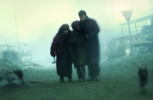Children of Men
The future isn’t what it used to be. Once upon a time, flying cars were the order of the day. When things were screwed up, it used to at least involve some reasonably cool technology, like robots, or time machines. Children of Men‘s 2027 has some shiny new sorts of advertisments on the sides of buses, but in the large it’s concerned with the future infertility of the entire human race.
Children of Men doesn’t go into how this happened, which works to its benefit — there’s no need to get concerned with blame, as by this stage the society has clearly moved on from any attempt to make sense of the tragedy. The government’s handing out suicide kits, for heaven’s sake. We’re on the way out.
In the middle of this depressing mess are Theo and Julian.1 He’s a tired, disillusioned ex-revolutionary. She’s his ex-lover, and the leader of a group of rebels. Together, they’re… well, actually, Theo is quite resistant to getting back into the whole business again, but when you live in a childless dystopia, there’s at least one thing that’s almost guaranteed to pull in even the most reluctant of people.
In a way, this movie is science fiction, but it acts like a suspense film. Things start off reasonably slowly with some quality, economic world-building and some neat references to modern political issues. But once we’re drawn into the story of Kee and everyone’s plans for her, things start to get a little tense. From this point, things only get more tense, at least until they become extremely tense. And it’s only then that things get amazingly tense. The film will get you thinking about some of the issues inherent in the story, about how far you’d go to save humanity, about how crazy the world could become without children, and about the idea of having responsibility for the future of your race. But primarily, the film will keep you glued to your seat.
Alfonso Cuarón, famous for Y Tu Mamá También and Harry Potter and the Prisoner of Azkaban, has gone in quite a different direction this time, and quite successfully. The dull dystopia is a tricky thing to present on screen without just seeming boring and drab; his Britain is washed-out and grainy, but far more involving and real than the cartoony vision seen in V for Vendetta.
Clive Owen’s Theo makes a good everyman — but a believably capable one, too. Like some of the best action heroes, everything he achieves seems like a struggle. Little touches in performace and direction — like his constant lack of decent footwear — do a good job of keeping the heroics he manages seeming real. Michael Caine, who seems to be in every film these days, puts in a memorably humourous and sad turn as a faded and un-jaded hippie. Serenity‘s Chiwetel Ejiofor is once again awesome as a somewhat conflicted character.
In a way, Children of Men feels like a small part of a bigger story,2 which may irritate people, but there’s plenty of closure at the end if that’s what you’re looking for. Like the best dramatic science fiction, the future that it depicts is explored not through ponderous speeches, but through the actions of well-drawn characters reacting to incredible circumstances.
- Julian’s a girl. Just so we’re clear. I would have spelled it in a girlier way, but I’m not about to disagree with IMDb. ↩
- In fact, it feels like The Fellowship of the Ring. Don’t laugh, I’m serious. That Kee looks not unlike a hobbit in her lothlorienesque threads was my first tip-off, but if you keep looking there’s all sorts of parallels. Just to get you started; Kee’s belly contains the ring, which will go on to pervert one of their party, and later turn them invisible. ↩



andy
December 4th, 2006 at 10:05 pm
Baby Diego’s death was a horrible shock for us all, and that was only the beginning of the movie. Tense is definitely the word, but with much needed humour. I loved the running gag about his trouble with footwear.
Each scene is filled with so much detail. In the backgound there are people are dying, dead animals, animated advertisements, and numerous other touches I’ve forgotten that make the world come alive. Anything outside of that time and place we’re only given sketchy information about – obeying the maxim of leaving the audience wanting more, which I guess given the premise, is probably best.
I was reminded more of the Matrix than FotR, because of the sketchy details about the rest of the world, it’s about a small struggle in amongst a larger crisis, the constant bullets and shrapnel, the potential for a great trilogy, the constant tension. These similarities are not strong, but together they brought back memories of a happier time, before Reloaded and Revolutions when I could admire the Matrix as a great stand-alone film.
Tom
December 4th, 2006 at 10:26 pm
The bleakness of colour and such definitely reminded me of The Matrix as well. The similarities to Fellowship are purely narrative. And really sketchy! This all has spoilers of course.
Andy
December 6th, 2006 at 8:02 pm
My favourite part was the escape from the rebel headquarters. The attempt at a stealthy escape was convincingly amateur and far more riveting than the stealthy escapades of secret agents and spies.
The camera work made me think of the way a video game. It’s the way it’s positioned as if it’s looking through the eyes of a someone who’s in the scene; hiding, low down and peaking around the corner. It’s an engaging angle and not used enough.